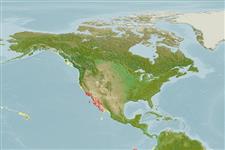Common names from other countries
Environment: milieu / climate zone / depth range / distribution range
Ecologia
marinhas demersal; não migratória; intervalo de profundidade 1 - 21 m (Ref. 2850), usually ? - 10 m (Ref. 56052). Subtropical
Eastern Central Pacific: southern California, USA to Puerto Marquez, Mexico, including the Gulf of California.
Tamanho / Peso / Idade
Maturity: Lm ? range ? - ? cm
Max length : 13.0 cm TL macho/indeterminado; (Ref. 2850); idade máx. registrada: 6 anos (Ref. 56052)
Adults are found in rocky areas (Ref. 37955), inhabiting holes and crevices, often in burrows of boring clams or tubes of marine worms, also in mussel beds (Ref. 2850). Mostly sedentary and territorial (Ref. 2850). Demersal spawners in nearshore habitats (Ref. 56049). Oviparous. Eggs are demersal and adhesive (Ref. 205), and are attached to the substrate via a filamentous, adhesive pad or pedestal (Ref. 94114). Larvae are planktonic, often found in shallow, coastal waters (Ref. 94114).
Oviparous, distinct pairing (Ref. 205).
Eschmeyer, W.N., E.S. Herald and H. Hammann, 1983. A field guide to Pacific coast fishes of North America. Boston (MA, USA): Houghton Mifflin Company. xii+336 p. (Ref. 2850)
Status na Lista Vermelha da UICN (Ref. 130435)
CITES (Ref. 128078)
Not Evaluated
Ameaça para os humanos
Harmless
Uso pelos humanos
Ferramentas
Relatórios especiais
Baixar XML
Fontes da internet
Estimates based on models
Preferred temperature (Ref.
115969): 14.9 - 24.3, mean 22.3 (based on 117 cells).
Índice de diversidade filogenética (Ref.
82804): PD
50 = 0.5000 [Uniqueness, from 0.5 = low to 2.0 = high].
Bayesian length-weight: a=0.01000 (0.00244 - 0.04107), b=3.04 (2.81 - 3.27), in cm Total Length, based on all LWR estimates for this body shape (Ref.
93245).
Nível Trófico (Ref.
69278): 2.8 ±0.2 se; based on size and trophs of closest relatives
Resiliência (Ref.
120179): médio(a), tempo mínimo de duplicação da população 1,4 - 4,4 anos (tmax=5.5; Fec = 1,540).
Fishing Vulnerability (Ref.
59153): Low vulnerability (10 of 100).
